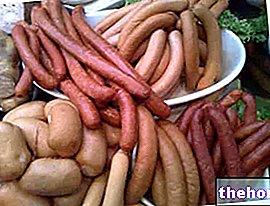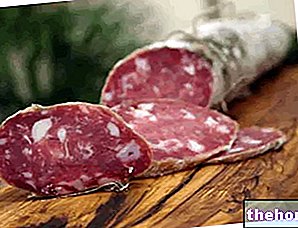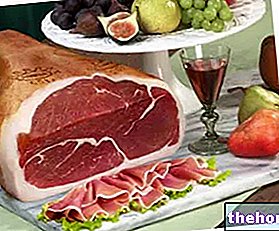Generality

As with other cured meats, salami are born from the attempt to maintain the edibility of pork as long as possible (pork - S. scrofa); the conservation principles (therefore antiseptics and antioxidants) that affect salami are:
- Reduction of free water for drying (Activity Water - AW)
- Seasoning and mild internal fermentation
- Increased sodium chloride (table salt - NaCl)
- Increase in saturated fat
- Introduction of spices, flavorings and other ingredients (pepper, red wine, often squeezed garlic, sometimes fennel seeds, sometimes red pepper, sometimes mace etc.)
- Shielding from the air (internally, for the elimination of bubbles, and externally, thanks to the action of the casing)
- Growth of molds outside the casing
- In commercial salamis, use of some food additives such as milk powder, dextrose, nitrites and nitrates.
Salami are foods belonging to the Italian gastronomic tradition even if, according to the territory, their "recipe" varies considerably. According to current legislation, the wording "salami" MUST necessarily be followed by the reference to the meats used since, even if to a lesser extent, salami based on avian, sheep, horse, game and offal meats (especially liver) are also marketed. , with blood etc. Even the natural casing, although traditionally made of pork, can originate from other animals such as sheep, cattle or horses, while the synthetic one is based on cellulose; on the contrary, the fat used for salami is always of swine origin.
NB. A type of tuna-based salami has recently been proposed (Genus Thunnus), even if its use is to be considered absolutely marginal and not yet sufficiently widespread (probably due to the intense flavor).
Homemade production
Let's start by specifying that the home-made production of salami is one of the most complex traditions to be handed down since, at each generational passage, the recipe suffers correction of the keeper. Furthermore, salamis are raw meat products, therefore easily perishable and difficult to mature; a small error in the production cycle is enough to cause the loss of the entire batch of salami.
Below we will try to summarize the key points of salami production, but without having the presumption of establishing a real production recipe; the quantitative doses will not be specified, both for safety reasons and in compliance with the specificity of the territory (variables of: raw material, climate, equipment, places of production and maturation, specific microorganisms, seasonality, etc.).
For the simple production of a generic garlic salami (and ALMOST certain invoice) it is necessary to obtain some ingredients such as: semi-fat pork (in blocks or pieces, but already deprived of waste such as bones, tendons, cartilages and rind, or ground and choice), ground pork fat (back fat, in block or already ground), STRICT pork casing (cleaned, washed and treated with vinegar; better to buy it from a butcher), red wine (well alcoholic and tannic), salt, black pepper (in grains and ground) and garlic. The equipment useful for the production of a few salamis can be made up of: steel table, cutting board, possibly a large container for the dough, small container for squeezing the garlic into wine, carving knife (very sharp), crank stuffing machine , twine for tying and fork. The rooms for the production, drying and curing of salami are: laboratory / kitchen for kneading and bagging, drying room and curing room. The process can be reduced to the essential by the following steps:
- Sanitation of equipment and premises before processing (unless you are lucky enough to operate in a dedicated laboratory)
- Preparation of the ingredients: if not ground, possible hand cut of the meat into small cubes (the size of one brunoise) and possible cutting of the fat by hand; husking of garlic; minced ½ of black pepper; dosage of wine; weighing of salt
- In the container for the dough or on the steel table, combine the meat, fat, pepper and salt
- Pour the wine into the small container
- In a tea towel, put the garlic in cloves, crush it, wrap the cloth on itself, dip it in the wine and squeeze it (so that the juice of the fresh garlic mixes with the wine) - squeeze several times
- Add the wine to the mixture
- Let the salami mixture rest and, in the meantime, taste the tastasale (possible correction)
- Prepare the stuffer
- Put small salami (length 20cm) into sausages, BEING CAREFUL NOT TO LEAVE BUBBLES OF AIR INSIDE, which would compromise its conservation and to BIND the vertices of the casing firmly.
- Prick the salami with a fork (to help drain the liquids in the first drying phase)
- Salt the salami on the outside
- Hang them in a room at room temperature (about 20 ° C) and away from windows for about 7 days (variable)
- Once dried, transfer the salami to a dark curing room with a cool temperature (about 10 ° C) for about 8-16 weeks
NB. The atmospheric humidity of the largest salamis, both in the drying phase and in the curing phase, must not be too low since an excessively rapid initial dehydration would affect only the external portion and would prevent a progressive drying / ripening of the heart of the salami; if necessary, moisten the skin of the salami during maturation.
Not many know that the shelf life of salamis is determined by the internal fermentation of some microorganisms and by the external colonization of white molds. Salami is a living food and as such it must be treated; similarly to wine and cheeses, sausages also NEVER go through a season the same as the previous one and this characteristic requires continuous monitoring and constant interaction between product and producer. It is very useful to insert a small portion of mature salami (from the previous year) into the fresh mixture in order to start the correct fermentation of the sausage.
Nutritional characteristics
Salami are high-calorie foods, high in triglycerides (especially saturated), cholesterol, and sodium chloride (table salt); these characteristics make them unsuitable for weight control diets and diets against hypercholesterolemia and hypertension.
The salamis are raw, therefore they are contraindicated to the pregnant woman's diet, both for the risk of parasitosis and for food poisoning; moreover, these preserved meats, if commercial, contain nitrites and nitrates, preservative molecules involved in the release of carcinogenic nitrosamines. Still with regard to commercial salamis, we remind you that, if they contain milk powder, they cannot be used in the diet due to lactose intolerance.
Salami are not "foods of this" era, since they provide a quantity of energy and fat that are often excessive for the sedentary consumer, and should be eaten in moderation, in small portions and occasionally.
Salami provide good amounts of high biological value proteins, potassium, iron, thiamin, riboflavin and niacin. See the nutritional values of various types of salami
Other Foods - Cured Meats and Sausages Bresaola Cotechino Culatello Guanciale Sausages Lard Mortadella Bacon Raw Ham Cooked Ham Ham Spanish Ham Salami Sausage Blood Pudding Speck Wurstel Zampone OTHER ARTICLES SALAMI Categories Alcoholic Food Meat Cereals and derivatives Sweeteners Sweets Offal Dried fruit Legs and Derivatives Milk and Derivatives Fish and fishery products Cured meats Spices Vegetables Health recipes Appetizers Bread, Pizza and Brioche First courses Second courses Vegetables and Salads Sweets and Desserts Ice creams and sorbets Syrups, liqueurs and grappa Basic Preparations ---- In the kitchen with leftovers Carnival recipes Christmas recipes Light diet recipes Women's, mom's and dad's day recipes Functional recipes International recipes Easter recipes Celiac recipes Diabetic recipes Holiday recipes Valentine's Day recipes Vegetarian recipes Protein recipes Regional recipes Vegan recipes
















.jpg)











